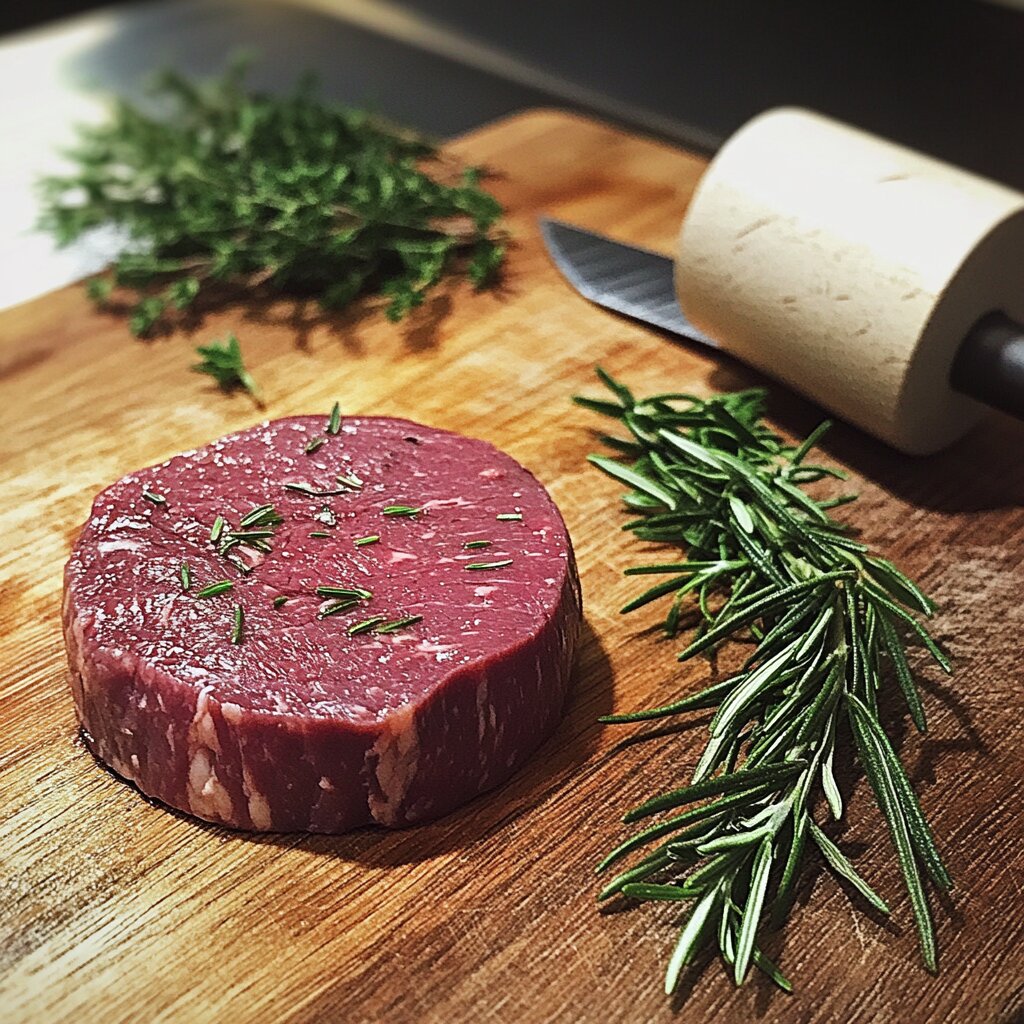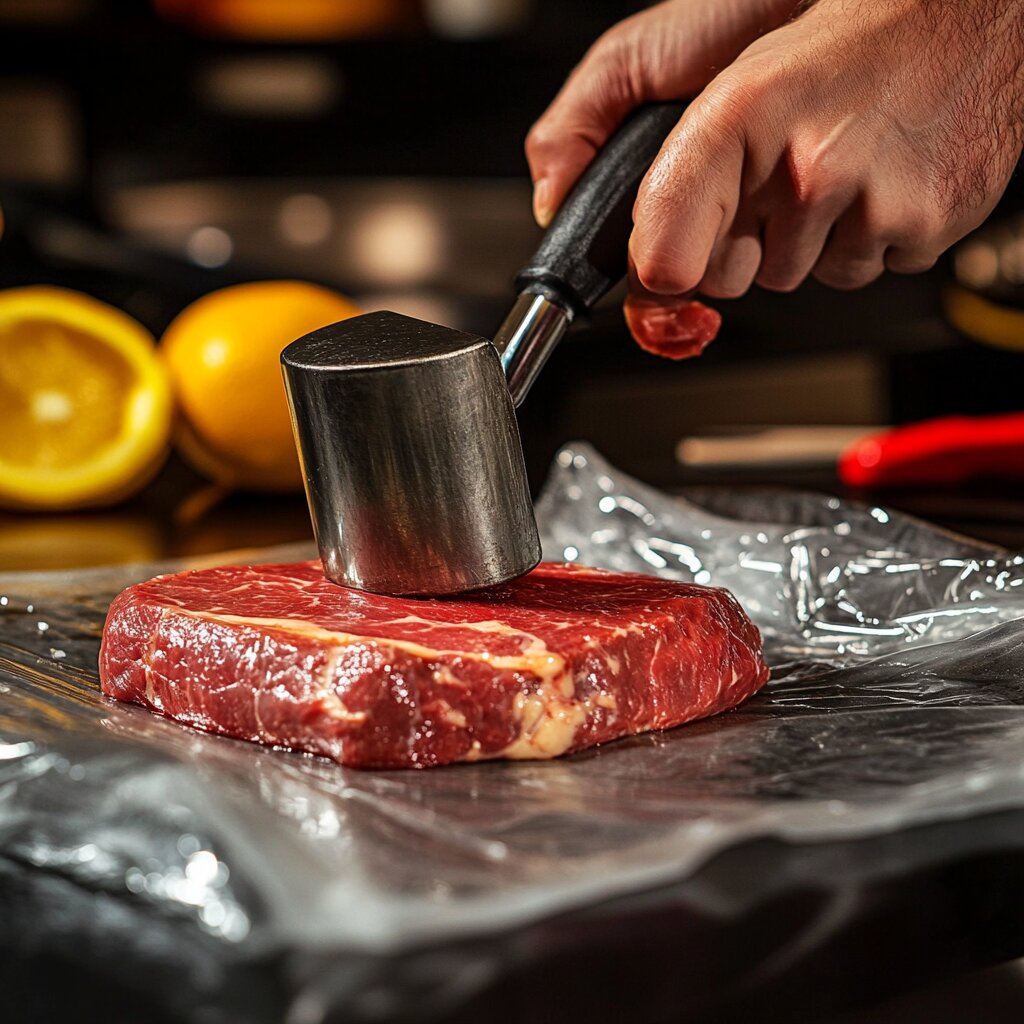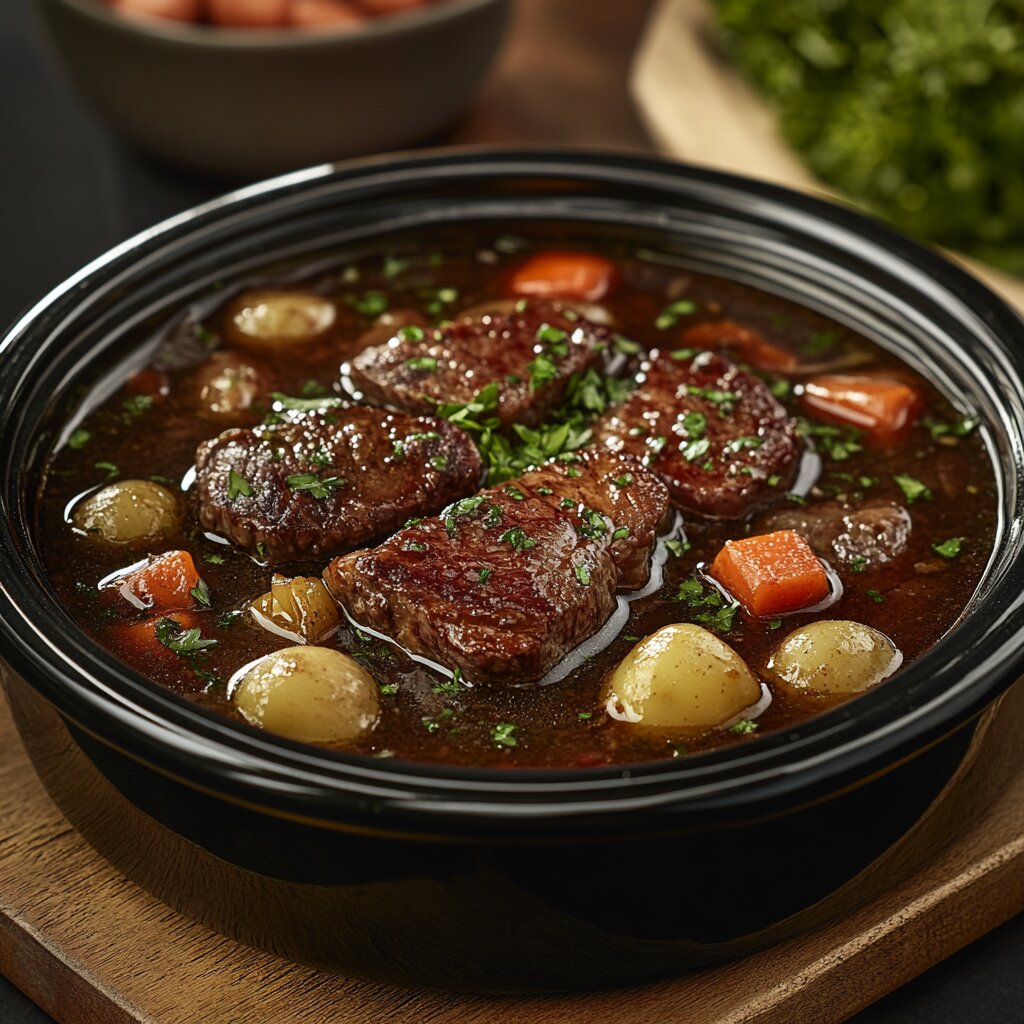
Round steak is an affordable and versatile cut of beef. However, if you know how to tenderize round steak properly, it becomes tender and flavorful. This guide covers the factors that affect tenderness, effective tenderizing methods, cooking techniques, marinades, and common mistakes to avoid. By mastering these tips, you can turn tough round steak into a delicious meal.
Table of Contents
Understanding Round Steak
What Is Round Steak?
Round steak is a lean cut of beef from the rear leg, specifically the “round” section. Butchers often sell it as large, flat slices. You may find different sub-cuts like top round, bottom round, and eye of round. Because it lacks marbling (intramuscular fat), this cut tends to be tougher than premium options like ribeye or sirloin. Despite this, round steak works well in dishes like stir-fries, stews, pot roasts, and Swiss steak. To enjoy its full potential, you need to use proper tenderizing techniques and cooking methods. For more inspiration, check out these Beef Round Steak Recipes that highlight delicious ways to prepare this cut.
Where Does Round Steak Come From?
Round steak comes from the upper thigh and hindquarters of the cow. This area, known as the “round” primal, supports the cow’s weight and helps with movement. Consequently, these muscles work hard, developing dense fibers and connective tissue. As a result, the meat is tougher than cuts from less-used parts of the cow. The round primal includes sub-cuts like the top round (the most tender), bottom round, and eye of round. Therefore, knowing where the meat comes from helps you choose the best cooking method for each sub-cut.
Why Is Round Steak Tough?
The toughness of round steak comes from its dense muscle fibers and high connective tissue content. Since the hindquarter muscles work continuously, they develop more collagen. This collagen makes the meat chewy unless broken down properly. Furthermore, the lack of marbling means there is less natural moisture and tenderness. High-heat cooking methods, like grilling, don’t break down the connective tissue. Instead, techniques like marinating, pounding, or slow-cooking help tenderize the meat. When you understand why round steak is tough, you can choose the right methods to tenderize round steak effectively.
Factors That Influence Tenderness
Muscle Composition and Connective Tissue
Round steak contains tightly packed muscle fibers and a lot of connective tissue. Because these muscles get a lot of exercise, they are dense and tough. Connective tissue, made of collagen, holds the fibers together. If you don’t break down this structure, the meat stays chewy. Therefore, tenderizing methods like pounding, scoring, or marinating are essential to weaken the muscle fibers. Additionally, Cooking methods like slow-cooking or braising break down the collagen, turning it into gelatin. These techniques help to tenderize round steak, making the meat tender and flavorful.
Aging Process and Its Impact
Aging improves beef’s tenderness by breaking down muscle fibers and connective tissue. There are two main types of aging: dry-aging and wet-aging. First, dry-aging involves hanging the beef in a controlled environment for several weeks. This process intensifies the flavor and tenderizes the meat. On the other hand, wet-aging involves vacuum-sealing the beef and letting it age in its own juices for 7 to 14 days. While this method still improves tenderness, it doesn’t enhance the flavor as much as dry-aging. Therefore, understanding the aging process helps you choose cuts that require less tenderizing.
Quality of the Meat
The quality of round steak affects how tender it will be. Beef quality grades include Prime, Choice, and Select. Prime beef has the most marbling, making it the most tender and flavorful. Choice beef has moderate marbling and can be tender with proper preparation. In contrast, Select beef is leaner and requires more tenderizing techniques. When buying round steak, look for bright red meat with minimal browning. Additionally, the fat should be firm and white. Fresh, high-quality meat needs less work to become tender. Meanwhile, lower-quality cuts benefit from pounding, marinating, and slow-cooking.
Effective Techniques to Tenderize Round Steak
Mechanical Tenderizing Methods
Using a Meat Mallet
A meat mallet breaks down the dense muscle fibers in round steak. To do this, place the meat between two pieces of plastic wrap to avoid mess. Then, pound the steak evenly until the fibers loosen. This process helps the meat cook more evenly and become tender. However, don’t over-pound, or the meat may become too thin and lose its structure.

Scoring the Meat
Scoring involves making shallow cuts across the surface of the steak. These cuts allow marinades to penetrate more deeply and help break up the muscle fibers. To score the meat, use a sharp knife to make crisscross cuts about ¼ inch deep. Consequently, this technique reduces shrinkage during cooking and helps the meat cook more evenly.
Chemical Tenderizing Methods
Marinating with Acidic Ingredients
Marinating with acidic ingredients helps break down the muscle fibers. Ingredients like vinegar, lemon juice, wine, or yogurt work well. For best results, combine your choice of acid with herbs, spices, and oil for flavor. Then, let the meat marinate for at least 2 hours or overnight. The acid not only tenderizes the meat but also adds flavor.

Enzymatic Tenderizers (Papain and Bromelain)
Enzymatic tenderizers use natural enzymes to break down protein fibers. Common options include papain (from papaya) and bromelain (from pineapple). You can add these enzymes to your marinade or use commercial tenderizing powders. However, be careful not to marinate too long, or the meat may become mushy. Generally, two to four hours is enough.
Cooking Techniques to Enhance Tenderness
Slow Cooking Methods
Slow cooking allows the connective tissue to break down gradually. Therefore, use a slow cooker or crockpot to simmer the meat for several hours. For added flavor, include broth, vegetables, and seasonings. Slow cooking is perfect for dishes like pot roast or beef stew. As a result, this method produces tender, juicy meat.

Braising and Stewing
Braising involves searing the meat first, then simmering it in liquid. Stewing uses smaller pieces of meat and more liquid. Both methods cook the meat slowly at low temperatures. As a result, the liquid keeps the meat moist while the slow heat breaks down the connective tissue. Ultimately, this process results in tender, flavorful beef.
Sous-Vide Cooking
Sous-vide cooking involves sealing the meat in a vacuum bag and cooking it in water at a precise temperature. This method ensures even cooking and tenderness. To do this, set the water temperature to around 130°F to 145°F (54°C to 63°C) and cook for 2 to 4 hours. Finally, finish by searing the meat for flavor.
Cooking methods like slow-cooking or braising are excellent ways to break down the collagen, turning it into gelatin. These techniques help to tenderize round steak, making the meat tender and flavorful. Learn more about How Round Steak Is Best Cooked to achieve the perfect texture.
Best Marinades for Round Steak
Classic Acid-Based Marinades
Classic acid-based marinades work well for tenderizing round steak. They use ingredients like vinegar, citrus juices, or wine, which help break down the muscle fibers. For example, a simple marinade could combine olive oil, lemon juice, garlic, and herbs like rosemary or thyme. Additionally, adding salt and pepper enhances the flavor. The acidity not only tenderizes the meat but also infuses it with a tangy flavor. To get the best results, let the steak marinate for at least 2 hours, or preferably overnight. However, be cautious not to marinate for too long, as the acid can make the meat mushy. Acid-based marinades are ideal for grilling or pan-searing because they add brightness and complexity to the dish.
Enzyme-Infused Marinades
Enzyme-infused marinades use natural enzymes to tenderize the meat. Ingredients like pineapple, papaya, or kiwi contain enzymes that break down proteins effectively. For example, pineapple juice contains bromelain, while papaya contains papain. These enzymes make round steak tender without altering its flavor significantly. To create an enzyme-infused marinade, mix the juice of one of these fruits with oil, garlic, and spices. However, it’s important to marinate for no more than 2 to 4 hours. If left too long, the enzymes can break down the meat too much, making it overly soft or mushy. Therefore, enzyme-infused marinades are perfect for quick tenderizing when you don’t have time for a long marination process.
Tips for Choosing the Right Round Steak
Identifying Fresh and High-Quality Cuts
Selecting fresh and high-quality round steak is crucial if you want to tenderize round steak effectively and achieve the best results. First, look for meat that has a bright red color, which indicates freshness. The surface should be moist but not slimy, and there should be minimal liquid pooling in the package. Additionally, check the fat. It should be firm and white, not yellow or greasy. Furthermore, smell the meat to ensure there is no sour or off odor. High-quality round steak will have a clean, slightly metallic smell. When buying from a butcher, don’t hesitate to ask about the source and how long the meat has been aged. By choosing fresh and high-quality cuts, you’ll set yourself up for success, no matter which tenderizing method you use.
Knowing the Different Grades of Beef
Beef quality is categorized into different grades based on marbling, tenderness, and overall quality. The three main grades are Prime, Choice, and Select. Prime beef has the most marbling, making it the most tender and flavorful option. However, it is also the most expensive. Choice beef offers a good balance of tenderness and affordability, with moderate marbling. It’s a great option for most home cooks. On the other hand, Select beef is leaner, with minimal marbling. Therefore, it tends to be tougher and requires more tenderizing techniques. When choosing round steak, understanding these grades can help you decide how much effort you need to invest in tenderizing the meat. Opt for Choice if you want a balance of quality and cost.
How to Cook Round Steak Perfectly
Preparing Round Steak for Cooking
Proper preparation makes a big difference in how your round steak turns out. First, trim off any excess fat or silver skin, which can cause the meat to become chewy. Then, decide on a tenderizing method. For instance, you can pound the steak with a meat mallet, score it, or marinate it. Additionally, if you plan to use a dry rub, apply it evenly and let the meat sit for at least 30 minutes. Before cooking, allow the steak to come to room temperature. This step ensures even cooking. Proper preparation sets the foundation for a tender and flavorful steak, no matter how you cook it.
Cooking Temperatures and Times
Cooking round steak to the right temperature is essential for tenderness. For medium-rare, aim for an internal temperature of 130°F to 135°F (54°C to 57°C). For medium, cook to 135°F to 145°F (57°C to 63°C). Use a meat thermometer to check the temperature accurately. Depending on the cooking method, adjust your times accordingly. For example, if you’re grilling, sear each side for about 4 to 5 minutes. For slow cooking, let the steak simmer for 4 to 6 hours. After cooking, let the steak rest for 5 to 10 minutes. This step allows the juices to redistribute, making the meat juicier. By following these guidelines, you can achieve the perfect round steak every time.
Common Mistakes to Avoid
Overcooking the Meat
One of the most common mistakes when cooking round steak is overcooking it. Because round steak is lean, overcooking can cause it to become dry and tough. To avoid this, use a meat thermometer to monitor the internal temperature. For best results, aim for medium-rare to medium doneness. Additionally, remember that the meat continues to cook slightly after you remove it from the heat. Therefore, pull the steak off the heat a few degrees before your target temperature. Avoiding overcooking ensures your round steak stays juicy and tender.
Skipping the Tenderizing Step
Skipping the tenderizing step is another mistake that leads to tough meat. Since round steak has dense muscle fibers, it needs tenderizing to achieve the best texture. Whether you choose to pound it, score it, marinate it, or cook it slowly, always tenderize round steak before cooking. This step is especially important for lower-quality cuts. By taking the time to tenderize, you’ll significantly improve the texture and flavor of the steak.
Not Letting the Meat Rest After Cooking
Letting the meat rest after cooking is crucial for maintaining juiciness. When you cook round steak, the juices move toward the center. If you cut the meat immediately, those juices will escape, leaving the steak dry. Instead, let the meat rest for 5 to 10 minutes. This allows the juices to redistribute evenly throughout the steak. As a result, you’ll enjoy a juicier, more flavorful piece of meat.
FAQs About Tenderizing Round Steak
What Is the Best Way to Tenderize Round Steak?
The best way to tenderize round steak depends on your time and tools. For quick results, use a meat mallet or an enzyme-based marinade. If you have more time, marinating the steak overnight with acidic ingredients or slow-cooking are excellent options. Combining methods, such as pounding and marinating, often yields the best results.
How Long Should I Marinate Round Steak?
For optimal tenderness, marinate round steak for at least 2 hours. For even better results, marinate overnight. However, if you’re using an enzyme-based marinade, keep the marination time under 4 hours to avoid a mushy texture.
Can I Use a Slow Cooker for Round Steak?
Yes, a slow cooker is one of the best tools for tenderizing round steak. The low and slow cooking method allows the connective tissue to break down gradually, resulting in tender, flavorful meat.
Why Is My Round Steak Still Tough?
If your round steak is still tough, you may not have tenderized it enough or cooked it properly. Additionally, overcooking or not letting the meat rest can lead to toughness.
How Does Aging Affect Round Steak?
Aging significantly impacts the tenderness and flavor of round steak. During the aging process, natural enzymes break down the muscle fibers and connective tissues, making the meat more tender. There are two primary aging methods: dry-aging and wet-aging. In dry-aging, beef is stored in a controlled environment for several weeks, allowing moisture to evaporate and flavors to concentrate. This method enhances both tenderness and a rich, beefy flavor. On the other hand, wet-aging involves vacuum-sealing the meat and letting it rest in its own juices for 7 to 14 days. Although wet-aging doesn’t develop as intense a flavor as dry-aging, it still improves tenderness. Ultimately, aged round steak will be easier to tenderize and more enjoyable to eat.
Is Round Steak Good for Grilling?
Yes, round steak can be good for grilling if you prepare it properly. Because it is a lean and tough cut, you need to tenderize it first by marinating, pounding, or scoring. A marinade with acidic or enzymatic ingredients helps break down muscle fibers and adds flavor. When grilling round steak, cook it quickly over high heat to avoid drying it out. Aim for medium-rare to medium doneness, as overcooking can make it tough. Let the steak rest for a few minutes after grilling to retain its juices. When done right, grilled round steak can be flavorful and tender.
Conclusion
In conclusion, round steak is a budget-friendly and versatile cut that can be incredibly tender and flavorful when treated correctly. By understanding its characteristics and using the right techniques to tenderize round steak, you can transform this tough cut into a satisfying mea. Factors such as muscle composition, aging, and beef quality all play a role in determining the meat’s tenderness. Additionally, methods like mechanical tenderizing, marinating, and slow-cooking are essential for breaking down dense muscle fibers and connective tissues.
Furthermore, cooking techniques like braising, slow-cooking, and sous-vide ensure the meat stays moist and tender. Selecting high-quality meat, avoiding common mistakes like overcooking, and using the right marinades also contribute to a successful dish. With these tips and techniques, you can confidently prepare round steak and enjoy a delicious, tender meal every time.
Now that you know the secrets to making round steak tender, it’s time to experiment in the kitchen. Whether you’re grilling, braising, or stewing, you can achieve amazing results with a little preparation and patience. Enjoy your cooking journey, and savor every bite of your perfectly tenderized round steak!
